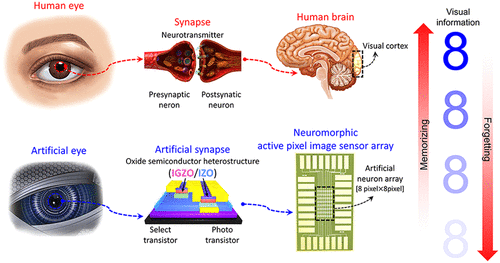Our official English website, www.x-mol.net, welcomes your
feedback! (Note: you will need to create a separate account there.)
Neuromorphic Active Pixel Image Sensor Array for Visual Memory
ACS Nano ( IF 15.8 ) Pub Date : 2021-08-31 , DOI: 10.1021/acsnano.1c06758 Seongin Hong 1, 2 , Haewon Cho 1 , Byung Ha Kang 3 , Kyungho Park 3 , Deji Akinwande 2 , Hyun Jae Kim 3 , Sunkook Kim 1
ACS Nano ( IF 15.8 ) Pub Date : 2021-08-31 , DOI: 10.1021/acsnano.1c06758 Seongin Hong 1, 2 , Haewon Cho 1 , Byung Ha Kang 3 , Kyungho Park 3 , Deji Akinwande 2 , Hyun Jae Kim 3 , Sunkook Kim 1
Affiliation

|
Neuromorphic engineering, a methodology for emulating synaptic functions or neural systems, has attracted tremendous attention for achieving next-generation artificial intelligence technologies in the field of electronics and photonics. However, to emulate human visual memory, an active pixel sensor array for neuromorphic photonics has yet to be demonstrated, even though it can implement an artificial neuron array in hardware because individual pixels can act as artificial neurons. Here, we present a neuromorphic active pixel image sensor array (NAPISA) chip based on an amorphous oxide semiconductor heterostructure, emulating the human visual memory. In the 8 × 8 NAPISA chip, each pixel with a select transistor and a neuromorphic phototransistor is based on a solution-processed indium zinc oxide back channel layer and sputtered indium gallium zinc oxide front channel layer. These materials are used as a triggering layer for persistent photoconductivity and a high-performance channel layer with outstanding uniformity. The phototransistors in the pixels exhibit both photonic potentiation and depression characteristics by a constant negative and positive gate bias due to charge trapping/detrapping. The visual memory and forgetting behaviors of the NAPISA can be successfully demonstrated by using the pulsed light stencil method without any software or simulation. This study provides valuable information to other neuromorphic devices and systems for next-generation artificial intelligence technologies.
中文翻译:

用于视觉记忆的神经形态有源像素图像传感器阵列
神经形态工程是一种模拟突触功能或神经系统的方法,在电子和光子学领域实现下一代人工智能技术方面引起了极大的关注。然而,为了模拟人类的视觉记忆,用于神经形态光子学的有源像素传感器阵列尚未得到证明,尽管它可以在硬件中实现人工神经元阵列,因为单个像素可以充当人工神经元。在这里,我们提出了一种基于非晶氧化物半导体异质结构的神经形态有源像素图像传感器阵列 (NAPISA) 芯片,模拟人类视觉记忆。在 8 × 8 NAPISA 芯片中,每个像素都有一个选择晶体管和一个神经形态光电晶体管,基于溶液处理的氧化铟锌背沟道层和溅射的铟镓锌氧化物前沟道层。这些材料用作持久光电导性的触发层和具有出色均匀性的高性能通道层。由于电荷俘获/释放,像素中的光电晶体管通过恒定的负和正栅极偏置表现出光子增强和抑制特性。NAPISA 的视觉记忆和遗忘行为可以通过使用脉冲光模板方法成功演示,无需任何软件或模拟。这项研究为下一代人工智能技术的其他神经形态设备和系统提供了有价值的信息。
更新日期:2021-09-28
中文翻译:

用于视觉记忆的神经形态有源像素图像传感器阵列
神经形态工程是一种模拟突触功能或神经系统的方法,在电子和光子学领域实现下一代人工智能技术方面引起了极大的关注。然而,为了模拟人类的视觉记忆,用于神经形态光子学的有源像素传感器阵列尚未得到证明,尽管它可以在硬件中实现人工神经元阵列,因为单个像素可以充当人工神经元。在这里,我们提出了一种基于非晶氧化物半导体异质结构的神经形态有源像素图像传感器阵列 (NAPISA) 芯片,模拟人类视觉记忆。在 8 × 8 NAPISA 芯片中,每个像素都有一个选择晶体管和一个神经形态光电晶体管,基于溶液处理的氧化铟锌背沟道层和溅射的铟镓锌氧化物前沟道层。这些材料用作持久光电导性的触发层和具有出色均匀性的高性能通道层。由于电荷俘获/释放,像素中的光电晶体管通过恒定的负和正栅极偏置表现出光子增强和抑制特性。NAPISA 的视觉记忆和遗忘行为可以通过使用脉冲光模板方法成功演示,无需任何软件或模拟。这项研究为下一代人工智能技术的其他神经形态设备和系统提供了有价值的信息。































 京公网安备 11010802027423号
京公网安备 11010802027423号